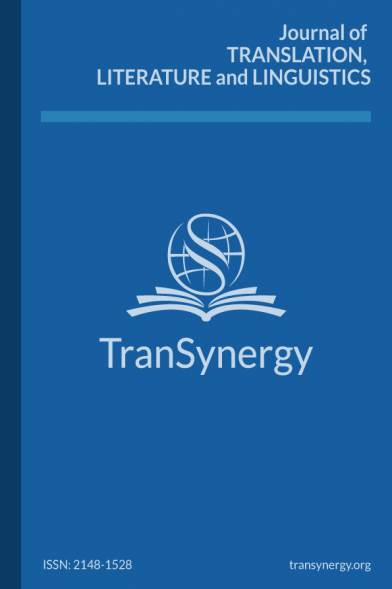Cars 2 Film and Its Translation into Turkish: A Relevance-Theoretical Approach to Translations of Puns and Wordplays
Keywords: translation studies, relevance theory, puns, wordplays, pragmatics
Cars 2 Film and Its Translation into Turkish: A Relevance-Theoretical Approach to Translations of Puns and Wordplays
Keywords: translation studies, relevance theory, puns, wordplays, pragmatics,
___
References
Bengi-Öner, I. (1999). Çeviri bir süreçtir… ya çeviribilim? Sel Yayıncılık.
Bengi-Öner, I. (2004). Çeviribilimde bireysel kuramlardan geniş ölçekli bir bakış açısına
doğru. In Rifat, M. (Ed.) Çeviri Seçkisi I: Çeviriyi Düşünenler. Sel Yayıncılık, s. 159-
172.
Cambridge Dictionary. (n.d.). Stick your nose into something. In Cambridge English
Dictionary. Date accessed 2024, January 14.
https://dictionary.cambridge.org/dictionary/english/stick-nose-into
Delabastita, D. (1994). Focus on pun: wordplay as a special problem in translation studies.
Target 6(2), 223-243.
Díaz-Pérez, F. J. (2014). Relevance theory and translation: translating puns in Spanish film
titles into English. Journal of Pragmatics 70, 108-129.
Doğan, G. (1992). The pragmatics of indeterminacy and indirectness of meaning: A
relevance-theoretic approach to epigrams and graffiti in Turkish. [Unpublished PhD
Thesis]. Manchester University.
Doğan, G. (2011, December 01-02). Poetic indexicals as threats to literary translation [Paper
presentation]. International Conference on Translation and Cross-Cultural
Communication. The Queensland University, Brisbane, Australia.
Doğan, G. (2022). Anlam ve bağıntı. BilgeSu.
González Davies, M., & Scott-Tennent, C. (2005). A problem-solving and student-centred
approach to the translation of cultural references. Meta: Journal Des Traducteurs,
50(1), 160. https://doi.org/10.7202/010666ar
Gutt, E. A. (1998). Pragmatic aspects of translation: some relevance-theory observations. In
Hickey, L. (Ed.), The Pragmatics of Translation. Multilingual Matters, s. 41-53.
Gutt, E. A. (2004). Challenges of metarepresentation to translation competence. In
Fleischmann, E., Schmitt, P. A., Wotjak, G. (Eds.) Translationskompetenz: Studien zur
Translation 14. Stauffenburg, s. 77–89.
Hatim, B. & Mason, I. (1997). The Translator as communicator. Routledge.
Lasseter, J. & Lewis, B. (Director). (2011). Cars 2 [Film]. Disney Pixar.
Shannon, C. & Weaver, W. (1949). The mathematics of communication. Scientific American
1(181), 11-15.
Sperber, D. & Wilson, D. (1987). Precis of relevance: communication and cognition. Behavioral
and Brain Sciences, 10(4), 697-704.
Sperber, D. & Wilson, D. (1995). Relevance: communication and cognition. Wiley Blackwell.
Thagard, P. (2023, January 31). Cognitive sciences. Stanford Encyclopaedia of Philosophy.
https://plato.stanford.edu/entries/cognitive-science/
Wilson, D. & Sperber, D. (2004). Relevance theory. In Horn, L.R., Ward, G. (Eds.), The
Handbook of Pragmatics. Blackwell Publishing, s. 607-632.
Xiao, S. (2022). Translation as transformation: on the treatment of puns and wordplay in
English translations of jinpingmei. European Journal of Literature, Language and
Linguistic Studies, 6(1), 1-19.
- ISSN: 2979-9503
- Yayın Aralığı: Yılda 2 Sayı
- Başlangıç: 19.12.2022
